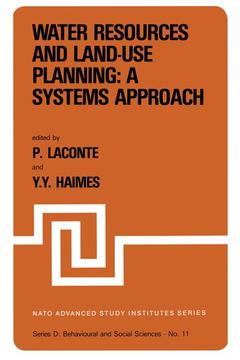Description
Water Resources and Land-Use Planning: A Systems Approach, Softcover reprint of the original 1st ed. 1982
Proceedings of the NATO Advanced Study Institute on: “Water Resources and LAnd-Use Planning” Louvain-la-Neuve, Belgium, July 3–14, 1978
NATO Science Series D: Series, Vol. 11
Coordinators: Laconte P., Haimes Y.Y.
Language: English
Subject for Water Resources and Land-Use Planning: A Systems Approach:
Publication date: 11-2011
470 p. · 15.5x23.5 cm · Paperback
470 p. · 15.5x23.5 cm · Paperback
Description
/li>Contents
/li>
This volume constitutes the proceedings of the NATO Advanced Study Institute on Water Resources and Land-Use Planning that was held in Louvain-la-Neuve, Belgium, July 3-14, 1978. In the pre paration of the two-week NASI, we identified 12 major goals and objectives, knowing well, at the time, that the satisfaction of all priorities would be an impossible task. It is instructive that we share these early goals and objectives with our readers prior to evaluating the NASI's contribution. 1. Relate and analyze water resources (water quantity and quality, surface and groundwater) and related land resources in a multi objective framework. 2. Identify and relate the scientific, technological, institu tional, societal, legal and political aspects of water and related land resources to policy decisions. 3. Promote and foster the transfer of technological information and assistance in water related land resources within the var ious levels of government. 4. Analyze the above three objectives and goals in light of the experience gained by the institute participants via case studies. 5. Improve communication and understanding among the various dis ciplines involved in water and related land resources. 6. Discuss and analyze the applicability of advanced planning methodologies germane to water and related land resources. 7. Identify current and projected future water and related land resources problems and issues and suggest ways to alleviate their respective and interrelated impacts.
1.0. General Introduction.- 2.0. Part 1 - Systems and Methods.- 2.1. Introduction.- 2.2. The Role and Limits of Normative Models in Water Resources Policy and Management.- 2.3. The Simulation of a Water Supply Control System to Solve a Multi-Objective Problem.- 2.4. Selecting the Appropriate Assessment Method.- 2.5. Selecting a Range of Alternatives by Individual or Group Decision-Makers.- 3.0. Part 2 - Subsystems.- 3.1. Introduction.- Water Resources Subsystems.- 3.2. Pre-Management Water Resources Study.- 3.3. Environmental Aspects of Water Management.- 3.4. Wastewater Treatment Technology.- 3.5. Ecological Aspects of Water Supply and Disposal.- 3.6. Marshing and Pseudo-Marshing in Waste-water Treatment.- LAND-USE SUBSYSTEMS.- 3.7. Water and Land Resources Planning.- 3.8 Water Resources and Land-Use - Some Agricultural Aspects.- 3.9. Rural Organization and Land-Water Balance.- HUMAN SUBSYSTEMS.- 3.10. Types of Urbanization and Sewerage Techniques.- 3.11. Socio-Cultural Aspects of Urban Hydrology.- 3.12. Integration of Land and Water Management Political, Administrative, and Planning Problems.- 3.13. Aspects of Water Resources Planning and Management in the Urbanization Process.- 4.0. PART 3 - CASE STUDIES.- 4.1. Introduction.- 4.2. Practical Aspects of Regional Planning - The Milwaukee Experience.- 4.3. An Application of Price Coordination Methods in Water Resources Systems.- 4.4. Water Resources Management in a Planned Unit Development: The Case of Louvain-la-Neuve, Belgium.- 4.5. A Visit to the Tailfer Plant of the Brussels Intercommunal Waterboard (C.I.B.E.).- 4.6. Environmental Aspects of Water Management in Indonesia.- 4.7. Water Problems and Land-Use Problems: Three Case Studies.- 5.0. General Conclusion.- 6.0. ABOUT THE AUTHORS.
© 2024 LAVOISIER S.A.S.




